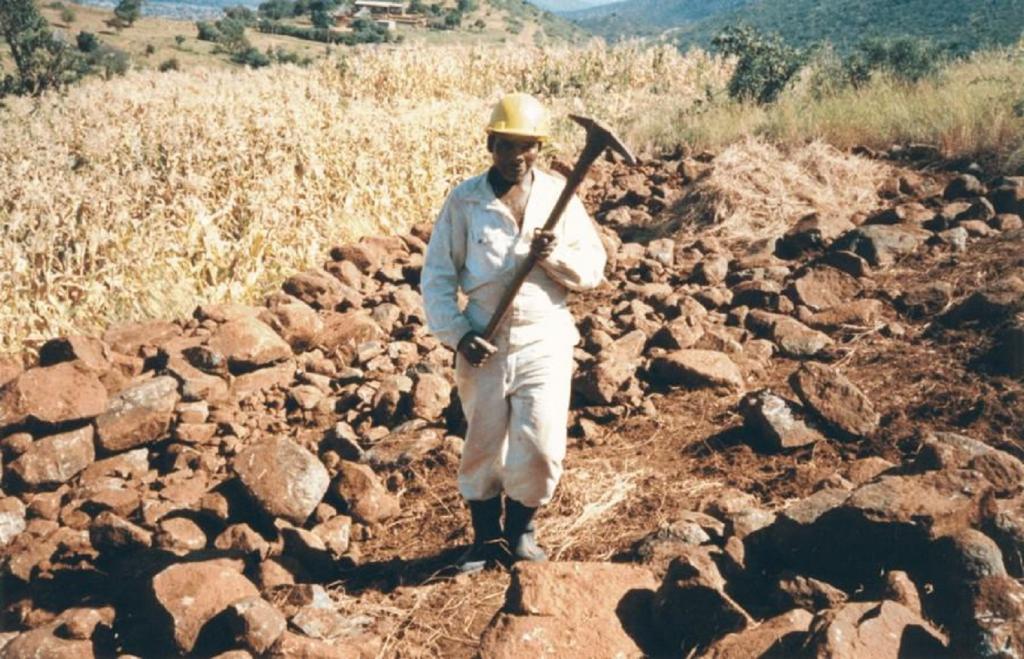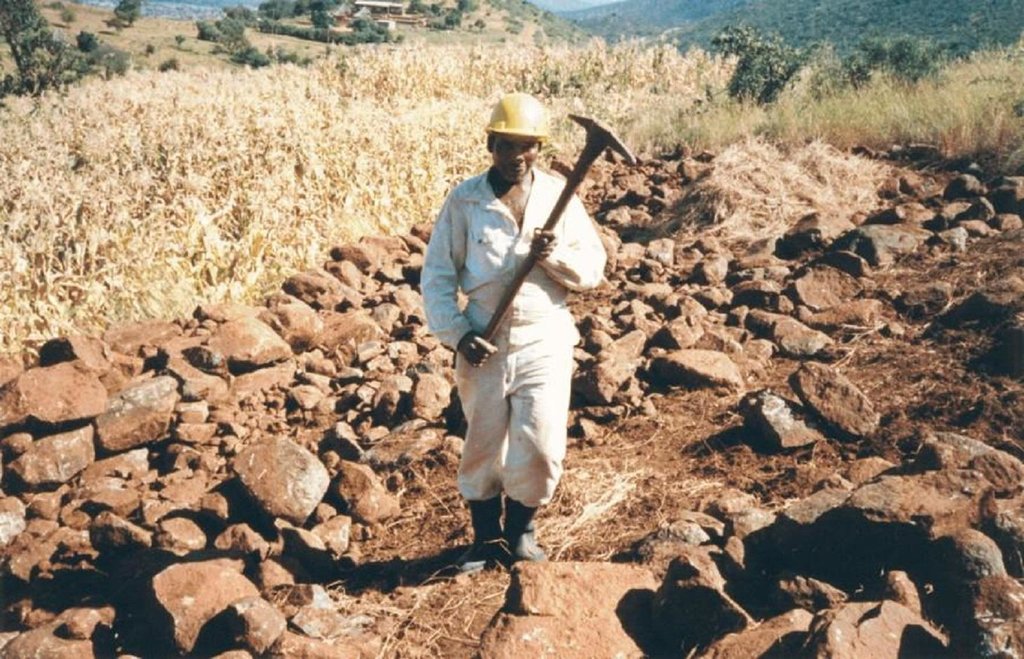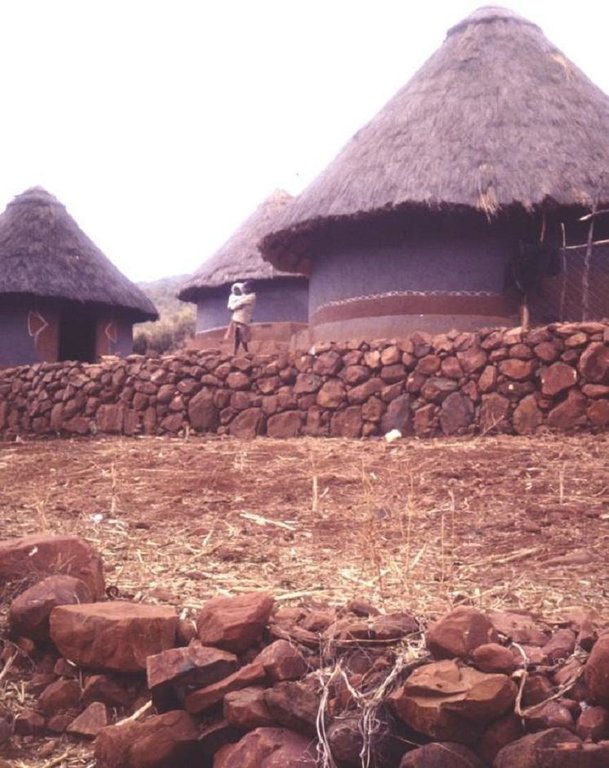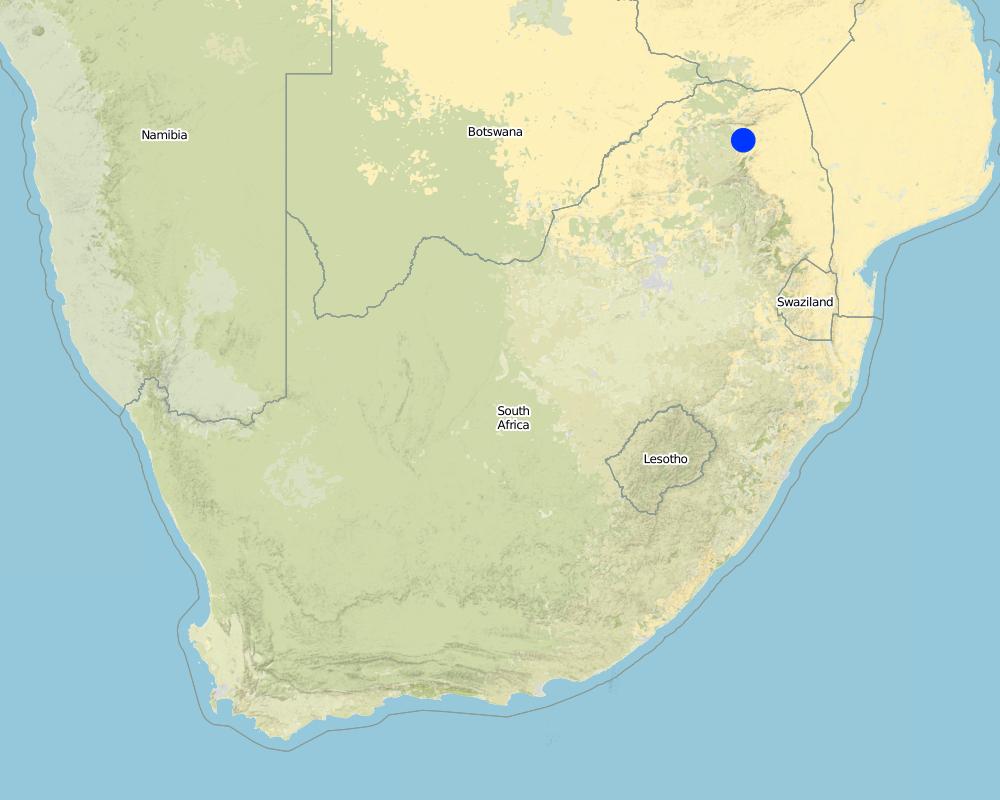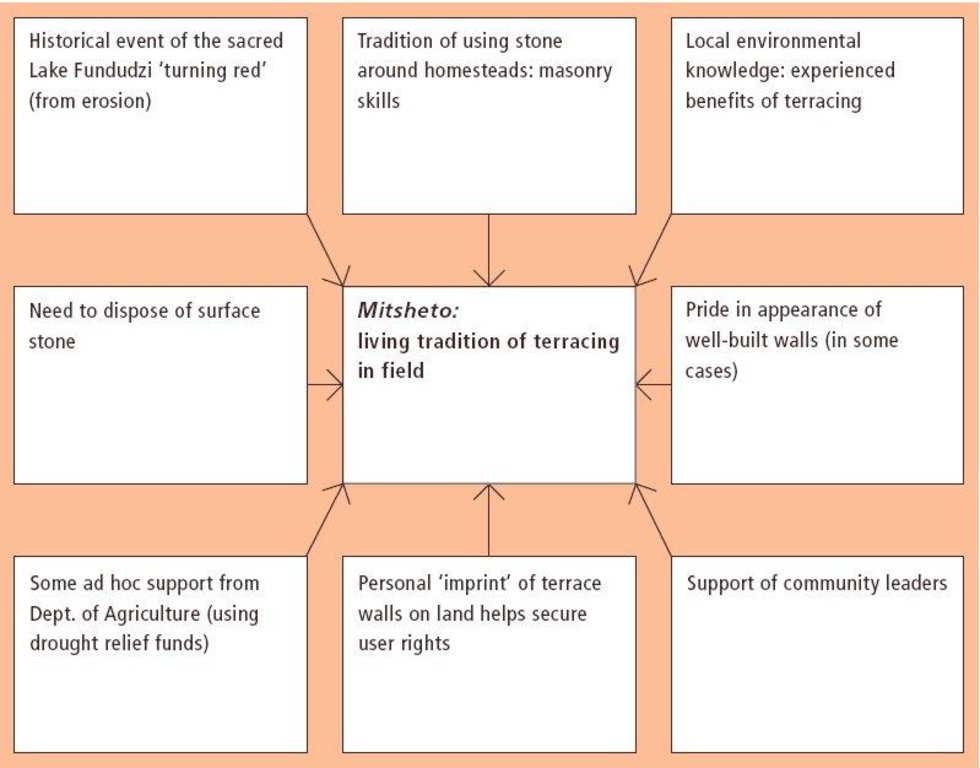Community tradition [جنوب أفريقيا]
- تاريخ الإنشاء:
- تحديث:
- جامع المعلومات: William Critchley
- المحرر: –
- المُراجع: Fabian Ottiger
approaches_2625 - جنوب أفريقيا
عرض الأقسام
توسيع الكل طي الكل1. معلومات عامة
1.2 تفاصيل الاتصال بالأشخاص الرئيسيين لمصدر المعلومات والمؤسسات المعنية بتقييم وتوثيق النهج
متخصص في الإدارة المستدامة للأراضي:
Van der Merwe Rinda
rinda@arc.agric.za
Institute for Soil, Climate and Water
P/Bag x79, 0001 Pretoria, South Africa
جنوب أفريقيا
اسم المؤسسة (المؤسسات) التي سهلت توثيق/تقييم النهج (إذا كان ذلك على صلة)
Institute for Soil, Climate & Water - جنوب أفريقيا1.3 الشروط المتعلقة باستخدام البيانات الموثقة من خلال WOCAT
يوافق جامع المعلومات والشخص (لاشخاص) الرئيسي لمصدر المعلومات على الشروط المتعلقة باستخدام البيانات الموثقة من خلال WOCAT:
نعم
1.4 المراجع الخاصة باستبيان(استبيانات) تقنيات الإدارة المستدامة للأراضي
2. وصف نهج الإدارة المستدامة للأراضي
2.1 وصف موجز للنهج
Inherited, and still practiced, tradition of stone terracing - passed down from generation to generation.
2.2 وصف تفصيلي للنهج
وصف تفصيلي للنهج:
Aims / objectives: The VhaVenda people of Limpopo Province in South Africa have a tradition of building with stone which has been passed down from generation to generation. They construct stone walls around their houses for example, taking a pride in the appearance of their homesteads. There is a historical monument nearby, the stone-built kraal at Dzata, the ruins of which are situated within a few kilometres of the study location. There may even be some evidence that the VhaVenda came originally from the area of the Great Zimbabwe (the famous stone-built fortress in Zimbabwe). It is not surprising therefore that the VhaVenda have used their masonry skills to build terraces in fields to counter erosion and simultaneously to make cultivation - along the contour by oxen - possible. This tradition has been passed down through the ages: it is institutionalised in the community and is practised together by men, women and children on a family basis. It is encouraged by community leaders: a particular example of this was in the 1960s when local chiefs were concerned at the sacred Lake Fundudzi 'turning red' - with sediment eroded from the land - and as a result they launched a conservation campaign to prevent soil wash into the lake. There has been modest and occasional support by the Department of Agriculture, in the form of ad hoc drought relief funds. There is quite a range of technical ability/care taken in terracing. Some walls are meticulously built; others are merely piles of stone across the slope. One of the reasons for this is that work tends to be done on an individual basis. Another result is that fields may take two years or more to be fully terraced. What is evident is that the land users - as well as being experienced masons -appreciate the benefits of the terraces they construct. An investigation of local environmental knowledge and conservation practices has demonstrated this clearly (see reference).
Methods: The causes of erosion were explained by the interviewees as being part natural (rainfall, slope etc) and part anthropogenic (poor road building, up and down ploughing, burning of grassland etc). The main negative impact of erosion was considered to be loss of soil fertility: hence terracing for protection. This indigenous knowledge also extends to soils: eight local soil types and their differences in terms of texture, fertility and erodibility are recognised in the study area.
2.3 صور عن النهج
2.5 البلد/المنطقة/المواقع التي تم تطبيق النهج فيها
البلد:
جنوب أفريقيا
المنطقة/الولاية/المحافظة:
Limpopo Province
Map
×2.7 نوع النهج
- تقليدي/أصلي
2.8 الغايات/الأهداف الرئيسية للنهج
The objective of the local people is simply to continue making cultivation possible and sustainable, through the local tradition of using stone walls to create terraces and to remove abundant stones from the field.
The SLM Approach addressed the following problems: - the tradition presumably arose as a spontaneous local response to degradation: it remains well entrenched - underlying problems of no flat land to cultivate, soil erosion/fertility decline on sloping fields, and loose stone and rocks impeding animal-draw ploughs
2.9 الظروف التي تمكن أو تعيق تنفيذ التقنية/التقنيات المطبقة بموجب النهج
غير ذلك
- معيق
labour: High labour demand to remove stone from inhibiting cultivation.
Treatment through the SLM Approach: Traditional teaching that such stone can be used constructively to improve conservation and yield benefits.
3. المشاركة وأدوار الأطراف المعنية
3.1 أصحاب المصلحة المعنيون بالنهج وأدوارهم
- مستخدمو الأراضي المحليون/المجتمعات المحلية
3.2 انخراط مستخدمي الأراضي المحليين/المجتمعات المحلية في المراحل المختلفة للنهج
| انخراط مستخدمي الأراضي المحليين/المجتمعات المحلية | حدد من شارك وصف الأنشطة | |
|---|---|---|
| المبادرة/التحفيز | التعبئة الذاتية | passing on knowledge; passing on of knowledge from generation to generation |
| التخطيط | التعبئة الذاتية | |
| التنفيذ | التعبئة الذاتية | family-based (or individual) construction |
| الرصد/التقييم | غير موجود | |
| Research | غير موجود |
3.3 مخطط التدفق (إذا كان متاحًا)
3.4 اتخاذ القرار بشأن اختيار تقنية/تقنيات الإدارة المستدامة للأراضي
حدد من الذي قرر اختيار التقنية/التقنيات التي سيتم تنفيذها:
- مستخدمو الأراضي وحدهم (المبادرة الذاتية)
اشرح:
Decisions on the method of implementing the SLM Technology were made by by land users* alone (self-initiative / bottom-up)
4. الدعم الفني وبناء القدرات وإدارة المعرفة
4.1 بناء القدرات/التدريب
هل تم تقديم التدريب لمستخدمي الأراضي / الأطراف المعنيين الآخرين؟:
نعم
المواضيع المغطاة:
There was/is no formal training - just father to son/mother to daughter.
4.2 خدمة استشارية
هل يملك مستخدمو الأراضي وصولا إلى خدمة استشارية؟:
نعم
حدد ما إذا كانت الخدمة الاستشارية متوفرة:
- في حقول مستخدمي الأراضي
وصف/تعليقات:
Key elements: Some encouragement from Department of Agriculture especially during soil and water conservation campaigns/drought relief periods.
4.3 تعزيز المؤسسات (التطوير التنظيمي)
هل تم إنشاء أو تعزيز مؤسسات من خلال هذا النهج؟:
- نعم، قليلا
حدد المستوى (المستويات) التي تم فيها تعزيز أو إنشاء المؤسسات:
- محلي
اعط مزيدا من التفاصيل:
support for SWC campaigns from local leaders
4.4 الرصد والتقييم
هل يشكل الرصد والتقييم جزءا من النهج؟:
نعم
التعليقات:
bio-physical aspects were ad hoc monitored through observations
technical aspects were ad hoc monitored through observations; indicators
economic / production aspects were ad hoc monitored through observations
area treated aspects were ad hoc monitored through observations
There were no changes in the Approach as a result of monitoring and evaluation
5. التمويل والدعم المادي الخارجي
5.1 الميزانية السنوية لمكون الإدارة المستدامة للأراضي في النهج المذكور
التعليقات (على سبيل المثال المصادر الرئيسية للتمويل/الجهات المانحة الرئيسية):
Approach costs were met by the following donors: government (national): 5.0%; local community / land user(s) (-): 95.0%
5.2 الدعم المالي/المادي المقدم لمستخدمي الأراضي
هل حصل مستخدمو الأراضي على دعم مالي/ مادي لتنفيذ التقنية/ التقنيات؟:
كلا
5.3 إعانات لمدخلات محددة (بما في ذلك العمالة)
إذا كان العمل من قبل مستخدمي الأراضي مدخلاً جوهريًا، فهل كان:
- تطوعي
التعليقات:
Almost entirely voluntary: some small support (approx 5% of the sample monitored) through Government during times of food scarcity with paid relief work.
A (very) small amount of drought relief in recent years from Government
5.4 الائتمان
هل تم توفير ائتمان في إطار نهج أنشطة الإدارة المستدامة للأراضي؟:
كلا
6. تحليل الأثر والتصريحات الختامية
6.1 آثار النهج
هل ساعد النهج مستخدمي الأراضي على تنفيذ وصيانة تقنيات الإدارة المستدامة للأراضي؟:
- لا
- نعم، قليلا
- نعم، باعتدال
- نعم، إلى حد كبير
Great: as part and parcel of the local tradition - for example contour ploughing is facilitated by the fact that the stone lines are on the contour, making this type of ploughing easier.
Did other land users / projects adopt the Approach?
- لا
- نعم، قليلا
- نعم، باعتدال
- نعم، إلى حد كبير
Only within this small pocket of Thohoyandou District (as far as known).
6.3 استدامة أنشطة النهج
هل يمكن لمستخدمي الأراضي المحافظة على استدامة ما تم تنفيذه من خلال النهج (بدون دعم خارجي)؟:
- نعم
إذا كانت الإجابة بنعم، صف كيف:
The VhaVenda have built terraces for generations so far, so no reason to think that things will change.
6.4 نقاط قوة/مزايا النهج
| نقاط القوة/ المزايا/ الفرص من وجهة نظر جامع المعلومات أو غيره من الاشخاص الرئيسيين لمصدر المعلومات |
|---|
| Traditional approaches have the potential to endure (How to sustain/ enhance this strength: Acknowledgement and encouragement by the Government and/or NGOs will help this.) |
6.5 نقاط الضعف/ العيوب في المنهج وطرق التغلب عليها
| نقاط الضعف/ المساوىء/ المخاطر من وجهة نظر جامع المعلومات أو غيره من الاشخاص الرئيسيين لمصدر المعلومات | كيف يمكن التغلب عليها؟ |
|---|---|
| This tradition was largely unrecognised until recently: therefore an opportunity was lost to encourage people and help the approach spread | Publicise widely and carry out farmer-to-farmer/community-to-community visits to further its spread and the spread of local SWC knowledge more generally. |
7. المراجع والروابط
7.1 طرق جمع/مصادر المعلومات
- زيارات ميدانية، مسوحات ميدانية
- مقابلات مع مستخدمي الأراضي
7.2 المراجع للمنشورات المتاحة
العنوان، المؤلف، السنة، النظام القياسي الدولي لترقيم الكتب ISBN:
Critchley W and Netshikhovehla E (1998) Conventional views, changing paradigms and a tradition of soil conservation.
الروابط والوحدات المواضيعية
توسيع الكل طي الكلالروابط
لا يوجد روابط
الوحدات المواضيعية
لا يوجد وحدات مواضيعية


